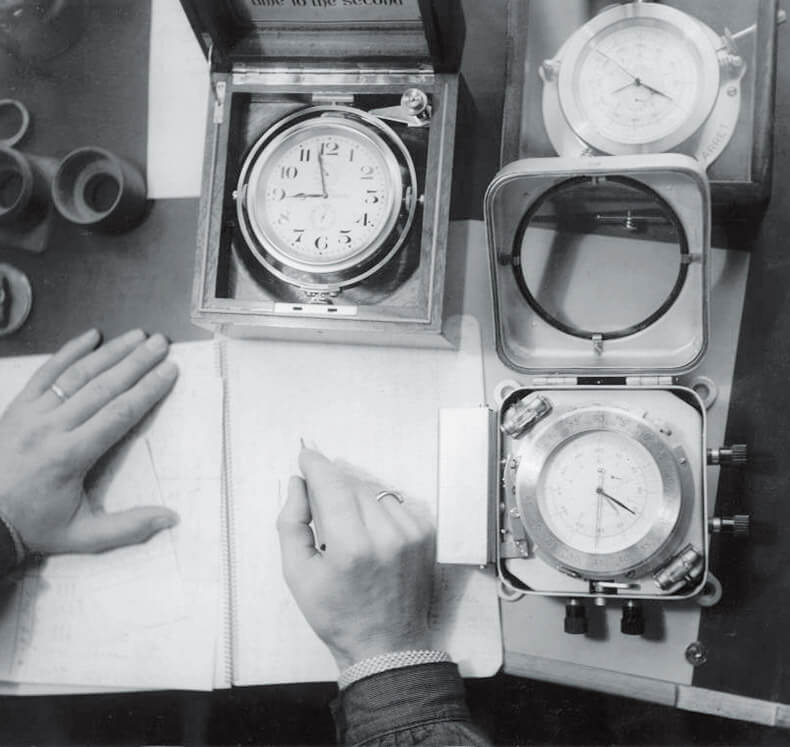
Paul-Emile Victor (third from left) with other team members of the expedition.
Nothing could stop Paul-Emile Victor. The son of a pipe manufacturer in the French Jura, he moved to live with the Innuits. An acclaimed scientist, he made it his goal to share his knowledge. LONGINES watches and devices were part of the core equipment used on his expeditions.
1907-1995
Paul-Emile Victor had no limits. He rejected societal norms, leaving his middle-class family to live with Innuits in a culture that was focused on seals. Geographical borders did not stop him in his quest to discover more and go further. It did not do so for himself, but rather to share the joy of discovery and his knowledge with as many people as possible by giving lectures, writing books and drawing the things he had had the opportunity to see and understand. He joined the navy and obtained his pilot’s licence, making land, sea and air all within his reach.
During World War II, he was a pilot and paratrooper in the U.S. Air Force. When peace was restored, he returned to France and founded the French Polar Expeditions. Over almost 30 years, Paul-Emile Victor led 150 expeditions searching for information to uncover the mystery of the poles. During this time, he trusted in the reliability and precision of LONGINES watches and instruments as they were resistant to the most extreme weather conditions.
During World War II, he was a pilot and paratrooper in the U.S. Air Force. When peace was restored, he returned to France and founded the French Polar Expeditions. Over almost 30 years, Paul-Emile Victor led 150 expeditions searching for information to uncover the mystery of the poles. During this time, he trusted in the reliability and precision of LONGINES watches and instruments as they were resistant to the most extreme weather conditions.
LONGINES chronometers were synchronised with an hourly radio signal and used to calculate astronomical points, which were essential to determine positions and routes. Members of the expeditions wore LONGINES wrist-watches, including a model (ref. 5483) which was reissued in 2010. Gaston Rouillon, deputy director, appreciated their perfect regularity and high level of accuracy, while assistant physicist, Jean-Claude Heuberger, was surprised that the watches could even withstand sea water. Marcel Ichac, a filmmaker who went with them, pointed out that even at temperatures up to –40° C (–40°F) for 49 days, the movement continued to work. Geologist Jean Ravier simply said: “I was delighted!”. Paul-Emile Victor even wrote to Saint-Imier saying: “I fondly remember the three LONGINES chronometers I took with me to calculate longitude during our crossing of the Greenland ice desert in 1936. They were the difference between failure and success.”
For LONGINES, this was the logical continuation of their long-standing commitment, starting in the late 19th century, to the explorers of the great ice deserts.
For LONGINES, this was the logical continuation of their long-standing commitment, starting in the late 19th century, to the explorers of the great ice deserts.

Paul-Emile Victor's favourite LONGINES was a deck chronometer (cal. 24.99). From 1908, LONGINES had been certifying their highly accurate timepieces, equipped with cal. 24.99, as observatory chronometers. Many of these precision instruments were purchased by American and British Admiralty to be used as a "Deck Watch".
“I FONDLY REMEMBER THE THREE LONGINES CHRONOMETERS I TOOK WITH ME TO CALCULATE LONGITUDE DURING OUR CROSSING OF THE GREENLAND ICE DESERT IN 1936. THEY WERE THE DIFFERENCE BETWEEN FAILURE AND SUCCESS.”

1907
Born in Geneva (Switzerland).
1929
He completed his military service in the French Navy.
1931
He received his pilot’s licence. He also served
in the U.S. Air Force during World War II.
1934
First contact with the Innuits. After spending a year with them, he was able to speak their language fluently.
1947
He founded and directed
the French Polar Expeditions which organised 150 expeditions in 29 years.
1962
After travelling the world, he realised the need to protect the environment and committed himself to this cause.
1995
He died in Bora Bora.

Geodesist measuring the Earth's geometric shape, Greenland, 1950.


